Managerial Accounting: Insurance Sector Remuneration and Performance
VerifiedAdded on 2020/02/19
|20
|5086
|31
Report
AI Summary
This report provides an analysis of managerial accounting concepts, focusing on performance measurement and executive remuneration within the insurance sector, specifically examining companies like IAG, AMP, and QBE. The study explores key aspects such as goal congruence, performance measurement systems, and financial measurement tools. It delves into executive pay, balanced scorecards, and the relationship between CEO performance and remuneration, including cash versus equity compensation, short-term and long-term incentives. The literature review covers goal congruence, motivation, remuneration, and the balanced scorecard. The discussion compares remuneration systems across the selected companies, assessing the effectiveness of these systems in relation to company performance and share price. The report highlights findings from IAG's remuneration report, including improvements in remuneration and the components considered in the company's policy. The analysis includes the director's and executive remuneration and their alignment with business strategy. The report provides insights into the various factors influencing the remuneration of the company's CEO and CFO, offering a comprehensive overview of the financial and non-financial performance measures used in the insurance sector.
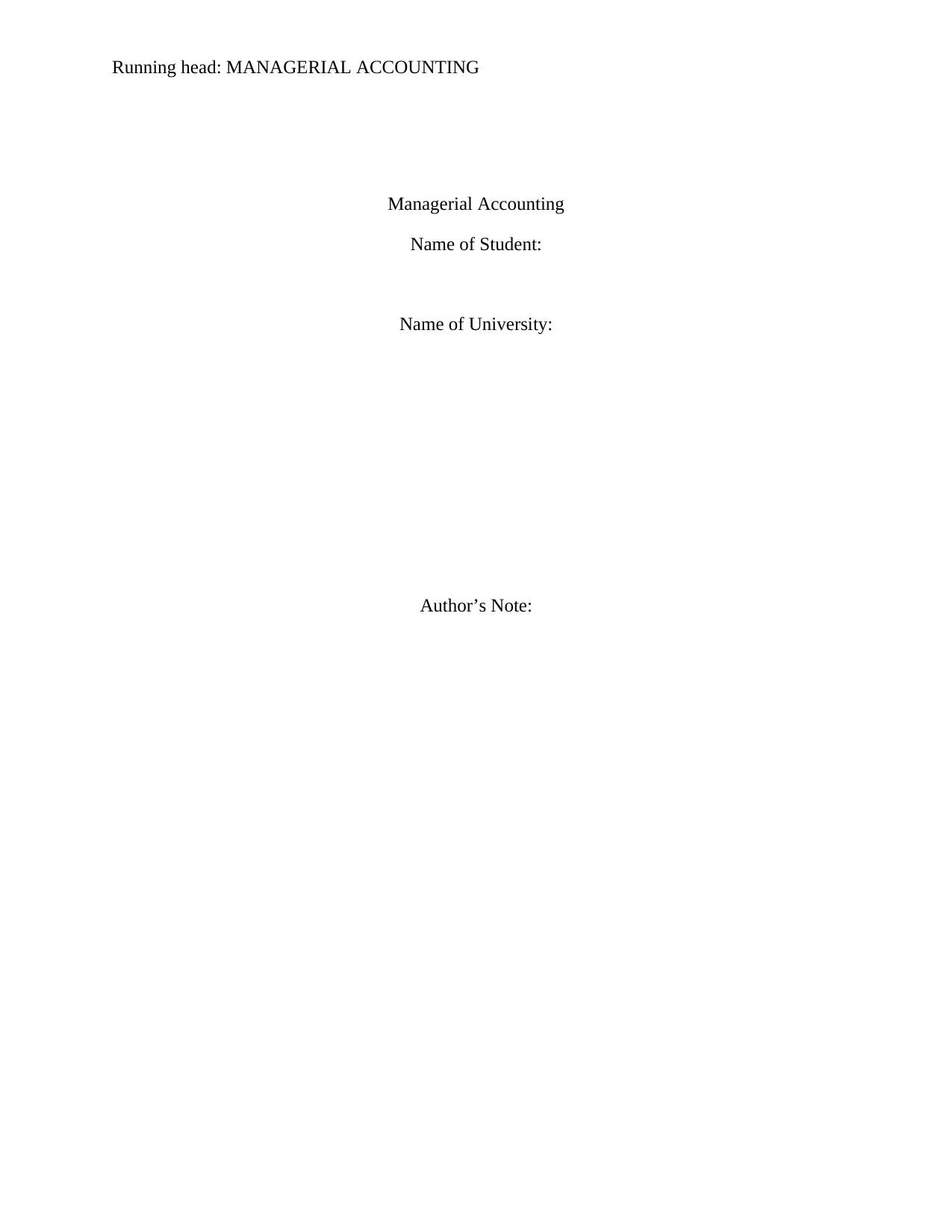
Running head: MANAGERIAL ACCOUNTING
Managerial Accounting
Name of Student:
Name of University:
Author’s Note:
Managerial Accounting
Name of Student:
Name of University:
Author’s Note:
Paraphrase This Document
Need a fresh take? Get an instant paraphrase of this document with our AI Paraphraser
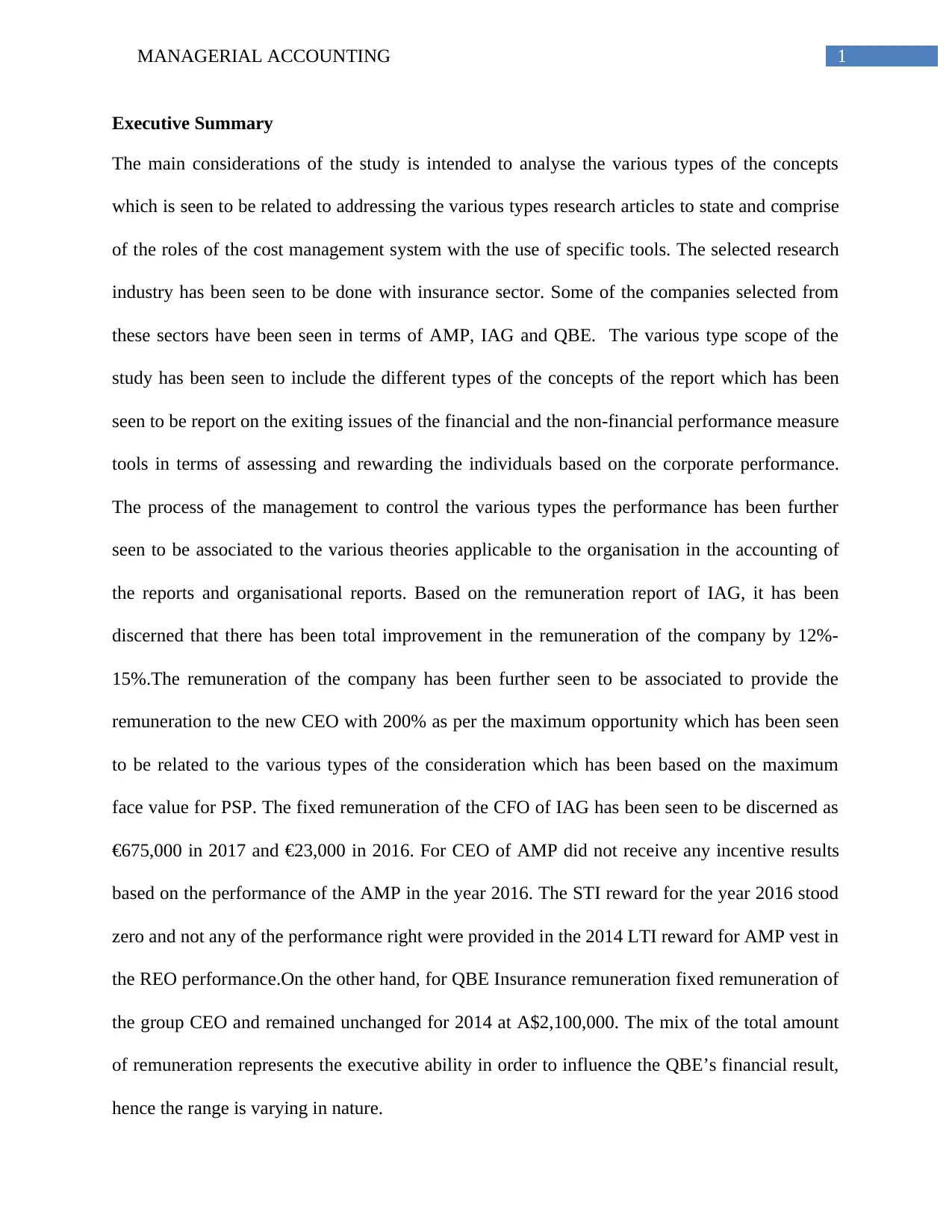
1MANAGERIAL ACCOUNTING
Executive Summary
The main considerations of the study is intended to analyse the various types of the concepts
which is seen to be related to addressing the various types research articles to state and comprise
of the roles of the cost management system with the use of specific tools. The selected research
industry has been seen to be done with insurance sector. Some of the companies selected from
these sectors have been seen in terms of AMP, IAG and QBE. The various type scope of the
study has been seen to include the different types of the concepts of the report which has been
seen to be report on the exiting issues of the financial and the non-financial performance measure
tools in terms of assessing and rewarding the individuals based on the corporate performance.
The process of the management to control the various types the performance has been further
seen to be associated to the various theories applicable to the organisation in the accounting of
the reports and organisational reports. Based on the remuneration report of IAG, it has been
discerned that there has been total improvement in the remuneration of the company by 12%-
15%.The remuneration of the company has been further seen to be associated to provide the
remuneration to the new CEO with 200% as per the maximum opportunity which has been seen
to be related to the various types of the consideration which has been based on the maximum
face value for PSP. The fixed remuneration of the CFO of IAG has been seen to be discerned as
€675,000 in 2017 and €23,000 in 2016. For CEO of AMP did not receive any incentive results
based on the performance of the AMP in the year 2016. The STI reward for the year 2016 stood
zero and not any of the performance right were provided in the 2014 LTI reward for AMP vest in
the REO performance.On the other hand, for QBE Insurance remuneration fixed remuneration of
the group CEO and remained unchanged for 2014 at A$2,100,000. The mix of the total amount
of remuneration represents the executive ability in order to influence the QBE’s financial result,
hence the range is varying in nature.
Executive Summary
The main considerations of the study is intended to analyse the various types of the concepts
which is seen to be related to addressing the various types research articles to state and comprise
of the roles of the cost management system with the use of specific tools. The selected research
industry has been seen to be done with insurance sector. Some of the companies selected from
these sectors have been seen in terms of AMP, IAG and QBE. The various type scope of the
study has been seen to include the different types of the concepts of the report which has been
seen to be report on the exiting issues of the financial and the non-financial performance measure
tools in terms of assessing and rewarding the individuals based on the corporate performance.
The process of the management to control the various types the performance has been further
seen to be associated to the various theories applicable to the organisation in the accounting of
the reports and organisational reports. Based on the remuneration report of IAG, it has been
discerned that there has been total improvement in the remuneration of the company by 12%-
15%.The remuneration of the company has been further seen to be associated to provide the
remuneration to the new CEO with 200% as per the maximum opportunity which has been seen
to be related to the various types of the consideration which has been based on the maximum
face value for PSP. The fixed remuneration of the CFO of IAG has been seen to be discerned as
€675,000 in 2017 and €23,000 in 2016. For CEO of AMP did not receive any incentive results
based on the performance of the AMP in the year 2016. The STI reward for the year 2016 stood
zero and not any of the performance right were provided in the 2014 LTI reward for AMP vest in
the REO performance.On the other hand, for QBE Insurance remuneration fixed remuneration of
the group CEO and remained unchanged for 2014 at A$2,100,000. The mix of the total amount
of remuneration represents the executive ability in order to influence the QBE’s financial result,
hence the range is varying in nature.
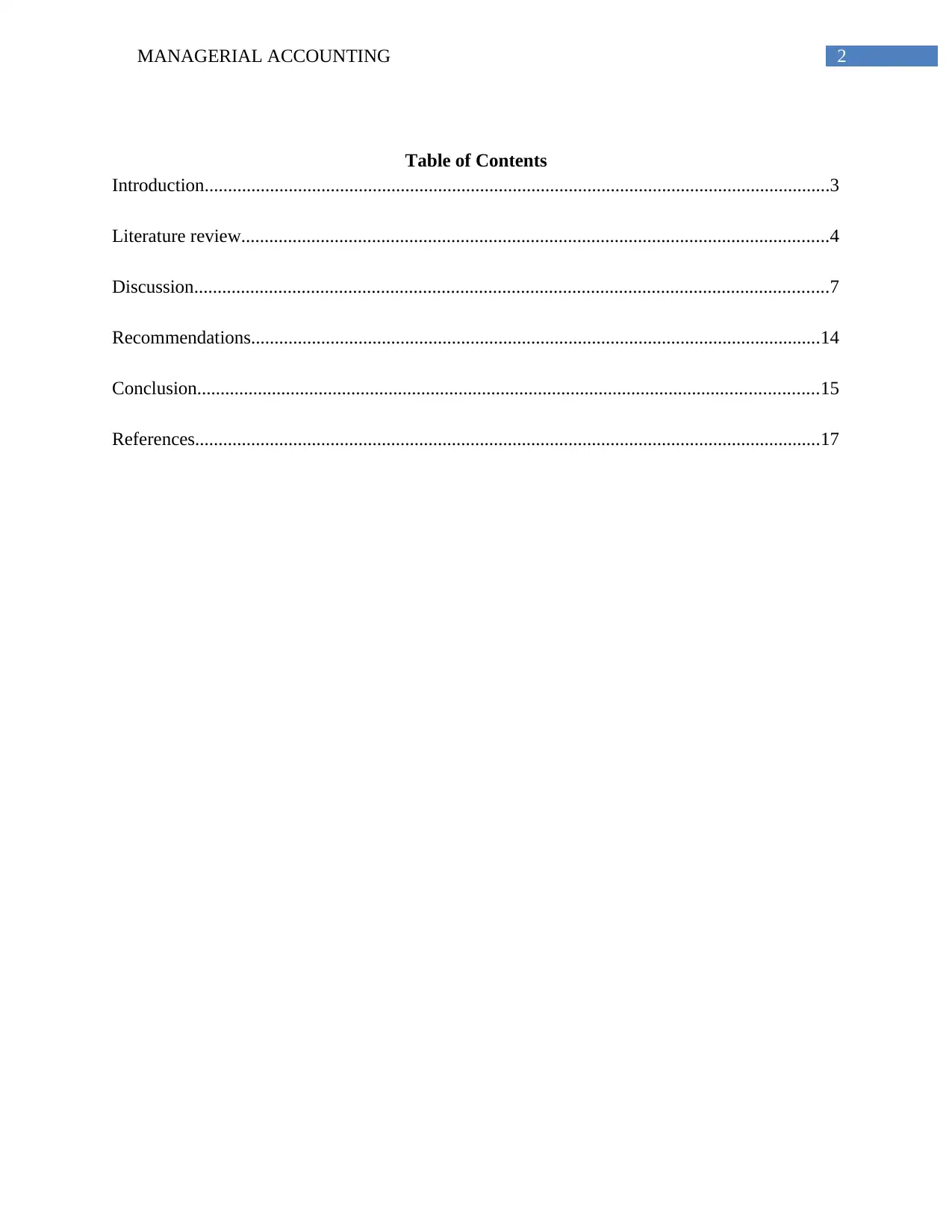
2MANAGERIAL ACCOUNTING
Table of Contents
Introduction......................................................................................................................................3
Literature review..............................................................................................................................4
Discussion........................................................................................................................................7
Recommendations..........................................................................................................................14
Conclusion.....................................................................................................................................15
References......................................................................................................................................17
Table of Contents
Introduction......................................................................................................................................3
Literature review..............................................................................................................................4
Discussion........................................................................................................................................7
Recommendations..........................................................................................................................14
Conclusion.....................................................................................................................................15
References......................................................................................................................................17
⊘ This is a preview!⊘
Do you want full access?
Subscribe today to unlock all pages.

Trusted by 1+ million students worldwide
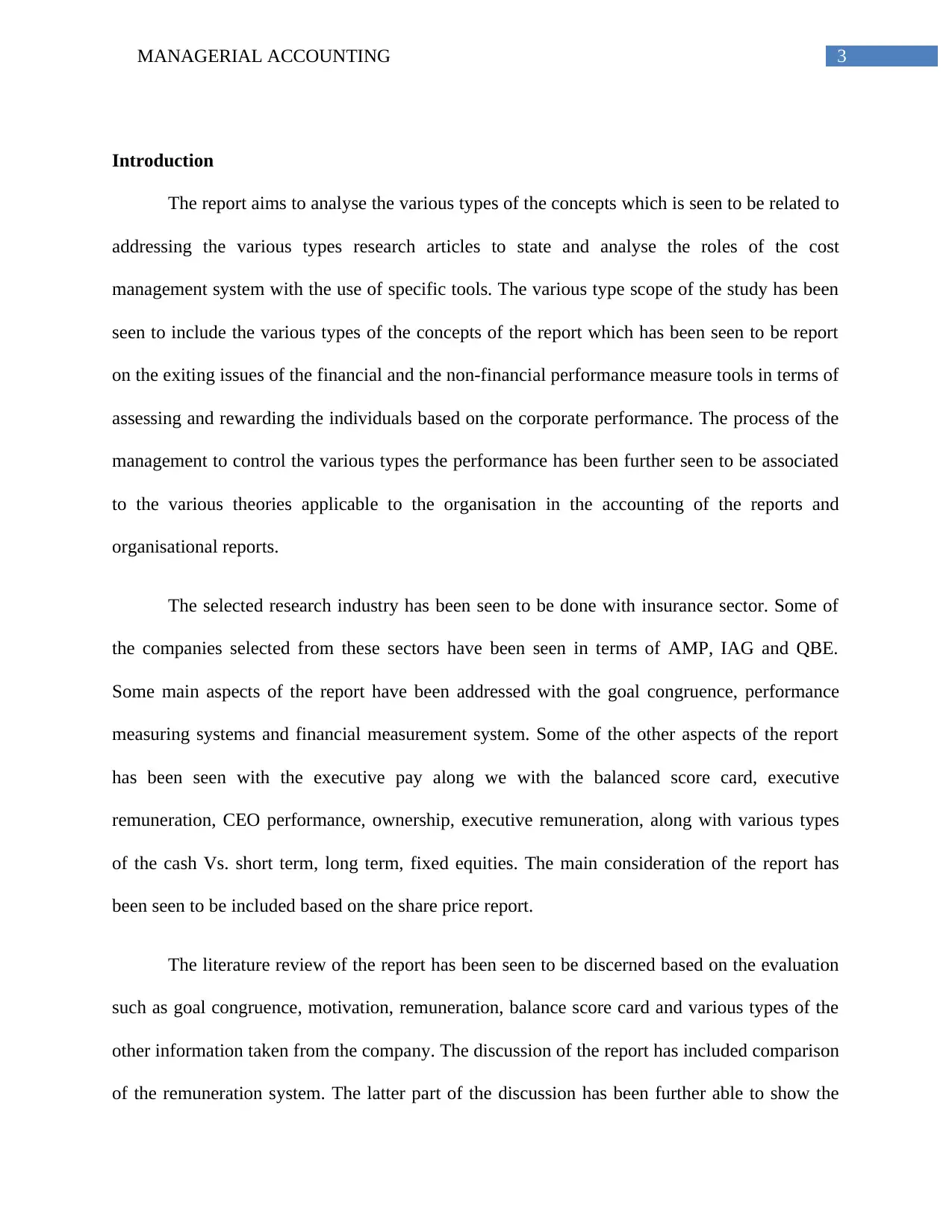
3MANAGERIAL ACCOUNTING
Introduction
The report aims to analyse the various types of the concepts which is seen to be related to
addressing the various types research articles to state and analyse the roles of the cost
management system with the use of specific tools. The various type scope of the study has been
seen to include the various types of the concepts of the report which has been seen to be report
on the exiting issues of the financial and the non-financial performance measure tools in terms of
assessing and rewarding the individuals based on the corporate performance. The process of the
management to control the various types the performance has been further seen to be associated
to the various theories applicable to the organisation in the accounting of the reports and
organisational reports.
The selected research industry has been seen to be done with insurance sector. Some of
the companies selected from these sectors have been seen in terms of AMP, IAG and QBE.
Some main aspects of the report have been addressed with the goal congruence, performance
measuring systems and financial measurement system. Some of the other aspects of the report
has been seen with the executive pay along we with the balanced score card, executive
remuneration, CEO performance, ownership, executive remuneration, along with various types
of the cash Vs. short term, long term, fixed equities. The main consideration of the report has
been seen to be included based on the share price report.
The literature review of the report has been seen to be discerned based on the evaluation
such as goal congruence, motivation, remuneration, balance score card and various types of the
other information taken from the company. The discussion of the report has included comparison
of the remuneration system. The latter part of the discussion has been further able to show the
Introduction
The report aims to analyse the various types of the concepts which is seen to be related to
addressing the various types research articles to state and analyse the roles of the cost
management system with the use of specific tools. The various type scope of the study has been
seen to include the various types of the concepts of the report which has been seen to be report
on the exiting issues of the financial and the non-financial performance measure tools in terms of
assessing and rewarding the individuals based on the corporate performance. The process of the
management to control the various types the performance has been further seen to be associated
to the various theories applicable to the organisation in the accounting of the reports and
organisational reports.
The selected research industry has been seen to be done with insurance sector. Some of
the companies selected from these sectors have been seen in terms of AMP, IAG and QBE.
Some main aspects of the report have been addressed with the goal congruence, performance
measuring systems and financial measurement system. Some of the other aspects of the report
has been seen with the executive pay along we with the balanced score card, executive
remuneration, CEO performance, ownership, executive remuneration, along with various types
of the cash Vs. short term, long term, fixed equities. The main consideration of the report has
been seen to be included based on the share price report.
The literature review of the report has been seen to be discerned based on the evaluation
such as goal congruence, motivation, remuneration, balance score card and various types of the
other information taken from the company. The discussion of the report has included comparison
of the remuneration system. The latter part of the discussion has been further able to show the
Paraphrase This Document
Need a fresh take? Get an instant paraphrase of this document with our AI Paraphraser
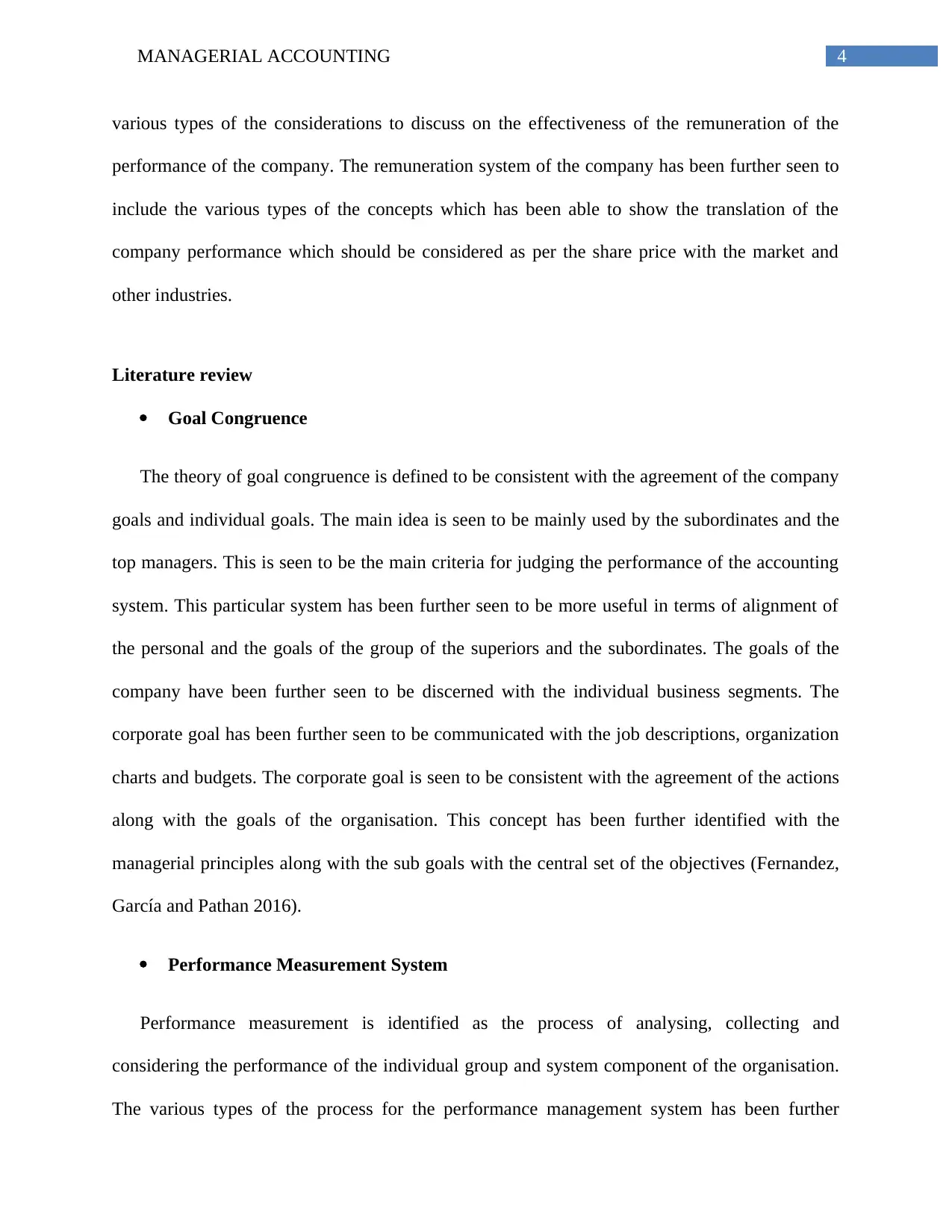
4MANAGERIAL ACCOUNTING
various types of the considerations to discuss on the effectiveness of the remuneration of the
performance of the company. The remuneration system of the company has been further seen to
include the various types of the concepts which has been able to show the translation of the
company performance which should be considered as per the share price with the market and
other industries.
Literature review
Goal Congruence
The theory of goal congruence is defined to be consistent with the agreement of the company
goals and individual goals. The main idea is seen to be mainly used by the subordinates and the
top managers. This is seen to be the main criteria for judging the performance of the accounting
system. This particular system has been further seen to be more useful in terms of alignment of
the personal and the goals of the group of the superiors and the subordinates. The goals of the
company have been further seen to be discerned with the individual business segments. The
corporate goal has been further seen to be communicated with the job descriptions, organization
charts and budgets. The corporate goal is seen to be consistent with the agreement of the actions
along with the goals of the organisation. This concept has been further identified with the
managerial principles along with the sub goals with the central set of the objectives (Fernandez,
García and Pathan 2016).
Performance Measurement System
Performance measurement is identified as the process of analysing, collecting and
considering the performance of the individual group and system component of the organisation.
The various types of the process for the performance management system has been further
various types of the considerations to discuss on the effectiveness of the remuneration of the
performance of the company. The remuneration system of the company has been further seen to
include the various types of the concepts which has been able to show the translation of the
company performance which should be considered as per the share price with the market and
other industries.
Literature review
Goal Congruence
The theory of goal congruence is defined to be consistent with the agreement of the company
goals and individual goals. The main idea is seen to be mainly used by the subordinates and the
top managers. This is seen to be the main criteria for judging the performance of the accounting
system. This particular system has been further seen to be more useful in terms of alignment of
the personal and the goals of the group of the superiors and the subordinates. The goals of the
company have been further seen to be discerned with the individual business segments. The
corporate goal has been further seen to be communicated with the job descriptions, organization
charts and budgets. The corporate goal is seen to be consistent with the agreement of the actions
along with the goals of the organisation. This concept has been further identified with the
managerial principles along with the sub goals with the central set of the objectives (Fernandez,
García and Pathan 2016).
Performance Measurement System
Performance measurement is identified as the process of analysing, collecting and
considering the performance of the individual group and system component of the organisation.
The various types of the process for the performance management system has been further
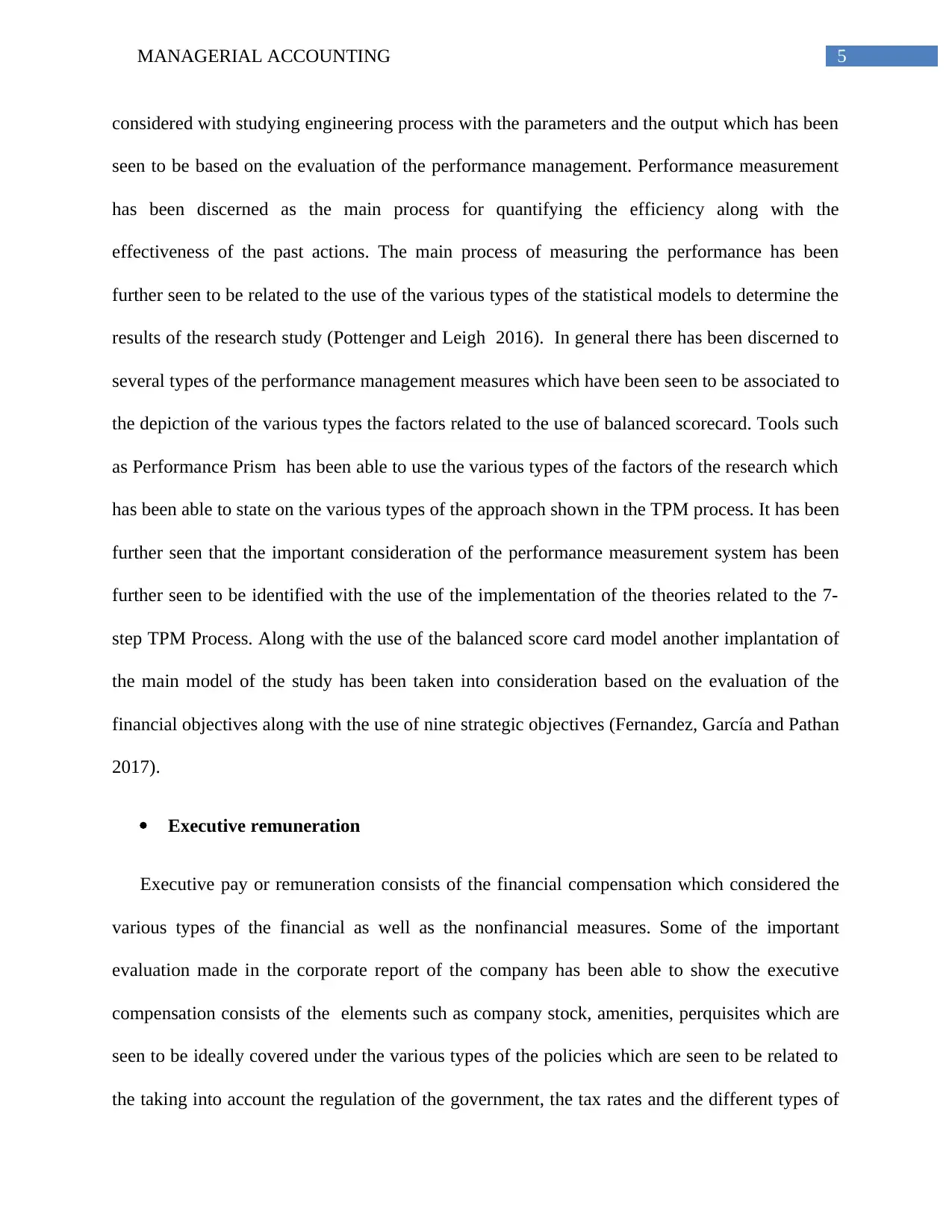
5MANAGERIAL ACCOUNTING
considered with studying engineering process with the parameters and the output which has been
seen to be based on the evaluation of the performance management. Performance measurement
has been discerned as the main process for quantifying the efficiency along with the
effectiveness of the past actions. The main process of measuring the performance has been
further seen to be related to the use of the various types of the statistical models to determine the
results of the research study (Pottenger and Leigh 2016). In general there has been discerned to
several types of the performance management measures which have been seen to be associated to
the depiction of the various types the factors related to the use of balanced scorecard. Tools such
as Performance Prism has been able to use the various types of the factors of the research which
has been able to state on the various types of the approach shown in the TPM process. It has been
further seen that the important consideration of the performance measurement system has been
further seen to be identified with the use of the implementation of the theories related to the 7-
step TPM Process. Along with the use of the balanced score card model another implantation of
the main model of the study has been taken into consideration based on the evaluation of the
financial objectives along with the use of nine strategic objectives (Fernandez, García and Pathan
2017).
Executive remuneration
Executive pay or remuneration consists of the financial compensation which considered the
various types of the financial as well as the nonfinancial measures. Some of the important
evaluation made in the corporate report of the company has been able to show the executive
compensation consists of the elements such as company stock, amenities, perquisites which are
seen to be ideally covered under the various types of the policies which are seen to be related to
the taking into account the regulation of the government, the tax rates and the different types of
considered with studying engineering process with the parameters and the output which has been
seen to be based on the evaluation of the performance management. Performance measurement
has been discerned as the main process for quantifying the efficiency along with the
effectiveness of the past actions. The main process of measuring the performance has been
further seen to be related to the use of the various types of the statistical models to determine the
results of the research study (Pottenger and Leigh 2016). In general there has been discerned to
several types of the performance management measures which have been seen to be associated to
the depiction of the various types the factors related to the use of balanced scorecard. Tools such
as Performance Prism has been able to use the various types of the factors of the research which
has been able to state on the various types of the approach shown in the TPM process. It has been
further seen that the important consideration of the performance measurement system has been
further seen to be identified with the use of the implementation of the theories related to the 7-
step TPM Process. Along with the use of the balanced score card model another implantation of
the main model of the study has been taken into consideration based on the evaluation of the
financial objectives along with the use of nine strategic objectives (Fernandez, García and Pathan
2017).
Executive remuneration
Executive pay or remuneration consists of the financial compensation which considered the
various types of the financial as well as the nonfinancial measures. Some of the important
evaluation made in the corporate report of the company has been able to show the executive
compensation consists of the elements such as company stock, amenities, perquisites which are
seen to be ideally covered under the various types of the policies which are seen to be related to
the taking into account the regulation of the government, the tax rates and the different types of
⊘ This is a preview!⊘
Do you want full access?
Subscribe today to unlock all pages.

Trusted by 1+ million students worldwide
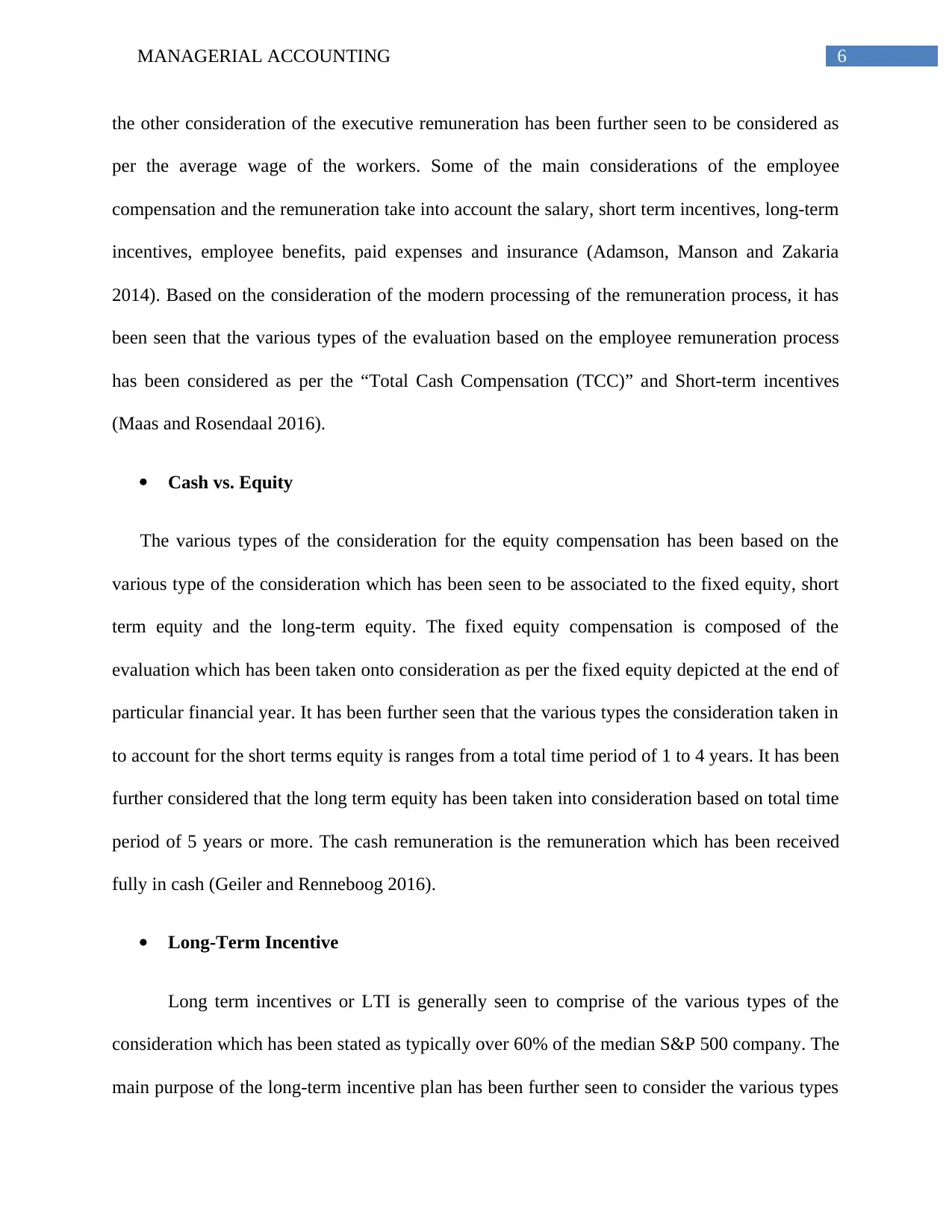
6MANAGERIAL ACCOUNTING
the other consideration of the executive remuneration has been further seen to be considered as
per the average wage of the workers. Some of the main considerations of the employee
compensation and the remuneration take into account the salary, short term incentives, long-term
incentives, employee benefits, paid expenses and insurance (Adamson, Manson and Zakaria
2014). Based on the consideration of the modern processing of the remuneration process, it has
been seen that the various types of the evaluation based on the employee remuneration process
has been considered as per the “Total Cash Compensation (TCC)” and Short-term incentives
(Maas and Rosendaal 2016).
Cash vs. Equity
The various types of the consideration for the equity compensation has been based on the
various type of the consideration which has been seen to be associated to the fixed equity, short
term equity and the long-term equity. The fixed equity compensation is composed of the
evaluation which has been taken onto consideration as per the fixed equity depicted at the end of
particular financial year. It has been further seen that the various types the consideration taken in
to account for the short terms equity is ranges from a total time period of 1 to 4 years. It has been
further considered that the long term equity has been taken into consideration based on total time
period of 5 years or more. The cash remuneration is the remuneration which has been received
fully in cash (Geiler and Renneboog 2016).
Long-Term Incentive
Long term incentives or LTI is generally seen to comprise of the various types of the
consideration which has been stated as typically over 60% of the median S&P 500 company. The
main purpose of the long-term incentive plan has been further seen to consider the various types
the other consideration of the executive remuneration has been further seen to be considered as
per the average wage of the workers. Some of the main considerations of the employee
compensation and the remuneration take into account the salary, short term incentives, long-term
incentives, employee benefits, paid expenses and insurance (Adamson, Manson and Zakaria
2014). Based on the consideration of the modern processing of the remuneration process, it has
been seen that the various types of the evaluation based on the employee remuneration process
has been considered as per the “Total Cash Compensation (TCC)” and Short-term incentives
(Maas and Rosendaal 2016).
Cash vs. Equity
The various types of the consideration for the equity compensation has been based on the
various type of the consideration which has been seen to be associated to the fixed equity, short
term equity and the long-term equity. The fixed equity compensation is composed of the
evaluation which has been taken onto consideration as per the fixed equity depicted at the end of
particular financial year. It has been further seen that the various types the consideration taken in
to account for the short terms equity is ranges from a total time period of 1 to 4 years. It has been
further considered that the long term equity has been taken into consideration based on total time
period of 5 years or more. The cash remuneration is the remuneration which has been received
fully in cash (Geiler and Renneboog 2016).
Long-Term Incentive
Long term incentives or LTI is generally seen to comprise of the various types of the
consideration which has been stated as typically over 60% of the median S&P 500 company. The
main purpose of the long-term incentive plan has been further seen to consider the various types
Paraphrase This Document
Need a fresh take? Get an instant paraphrase of this document with our AI Paraphraser
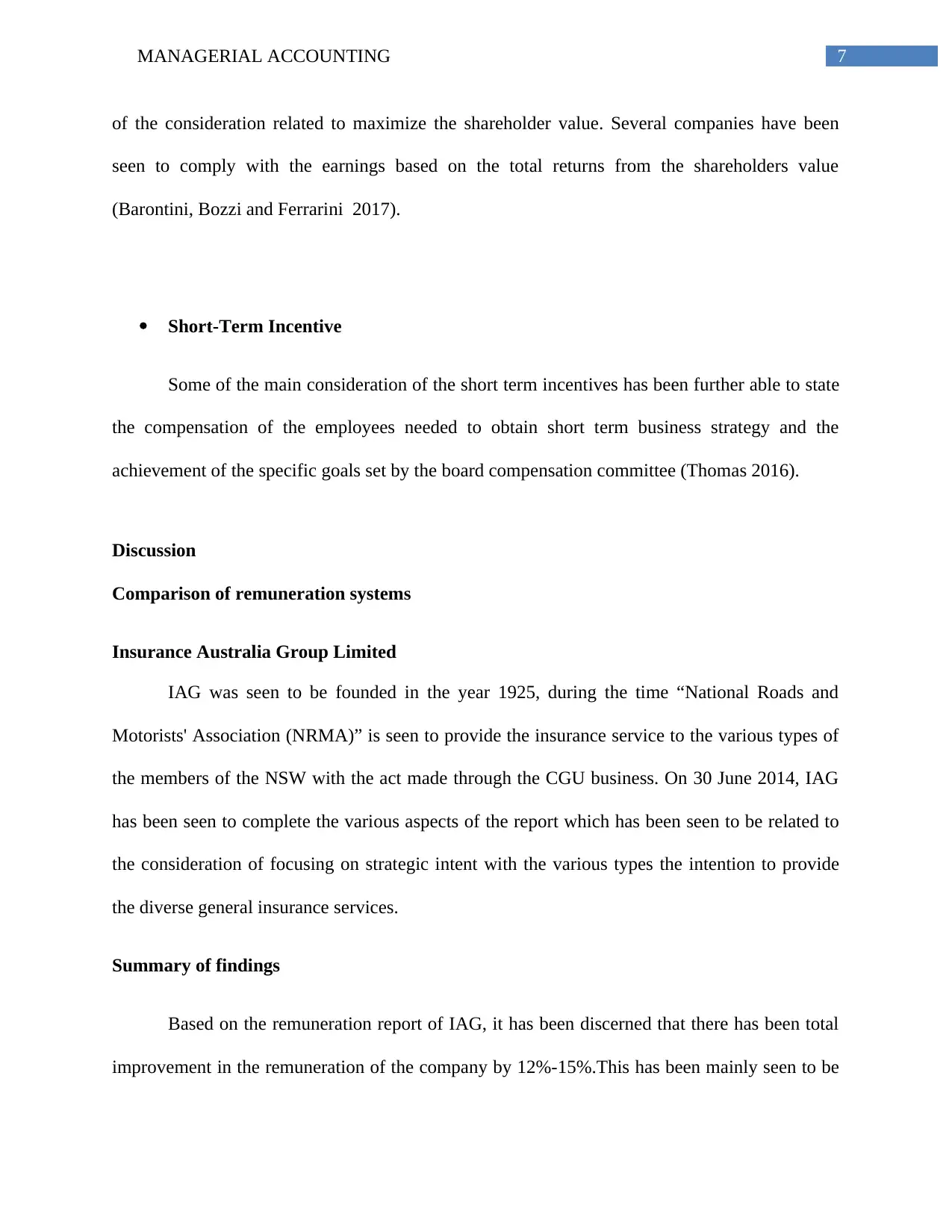
7MANAGERIAL ACCOUNTING
of the consideration related to maximize the shareholder value. Several companies have been
seen to comply with the earnings based on the total returns from the shareholders value
(Barontini, Bozzi and Ferrarini 2017).
Short-Term Incentive
Some of the main consideration of the short term incentives has been further able to state
the compensation of the employees needed to obtain short term business strategy and the
achievement of the specific goals set by the board compensation committee (Thomas 2016).
Discussion
Comparison of remuneration systems
Insurance Australia Group Limited
IAG was seen to be founded in the year 1925, during the time “National Roads and
Motorists' Association (NRMA)” is seen to provide the insurance service to the various types of
the members of the NSW with the act made through the CGU business. On 30 June 2014, IAG
has been seen to complete the various aspects of the report which has been seen to be related to
the consideration of focusing on strategic intent with the various types the intention to provide
the diverse general insurance services.
Summary of findings
Based on the remuneration report of IAG, it has been discerned that there has been total
improvement in the remuneration of the company by 12%-15%.This has been mainly seen to be
of the consideration related to maximize the shareholder value. Several companies have been
seen to comply with the earnings based on the total returns from the shareholders value
(Barontini, Bozzi and Ferrarini 2017).
Short-Term Incentive
Some of the main consideration of the short term incentives has been further able to state
the compensation of the employees needed to obtain short term business strategy and the
achievement of the specific goals set by the board compensation committee (Thomas 2016).
Discussion
Comparison of remuneration systems
Insurance Australia Group Limited
IAG was seen to be founded in the year 1925, during the time “National Roads and
Motorists' Association (NRMA)” is seen to provide the insurance service to the various types of
the members of the NSW with the act made through the CGU business. On 30 June 2014, IAG
has been seen to complete the various aspects of the report which has been seen to be related to
the consideration of focusing on strategic intent with the various types the intention to provide
the diverse general insurance services.
Summary of findings
Based on the remuneration report of IAG, it has been discerned that there has been total
improvement in the remuneration of the company by 12%-15%.This has been mainly seen to be
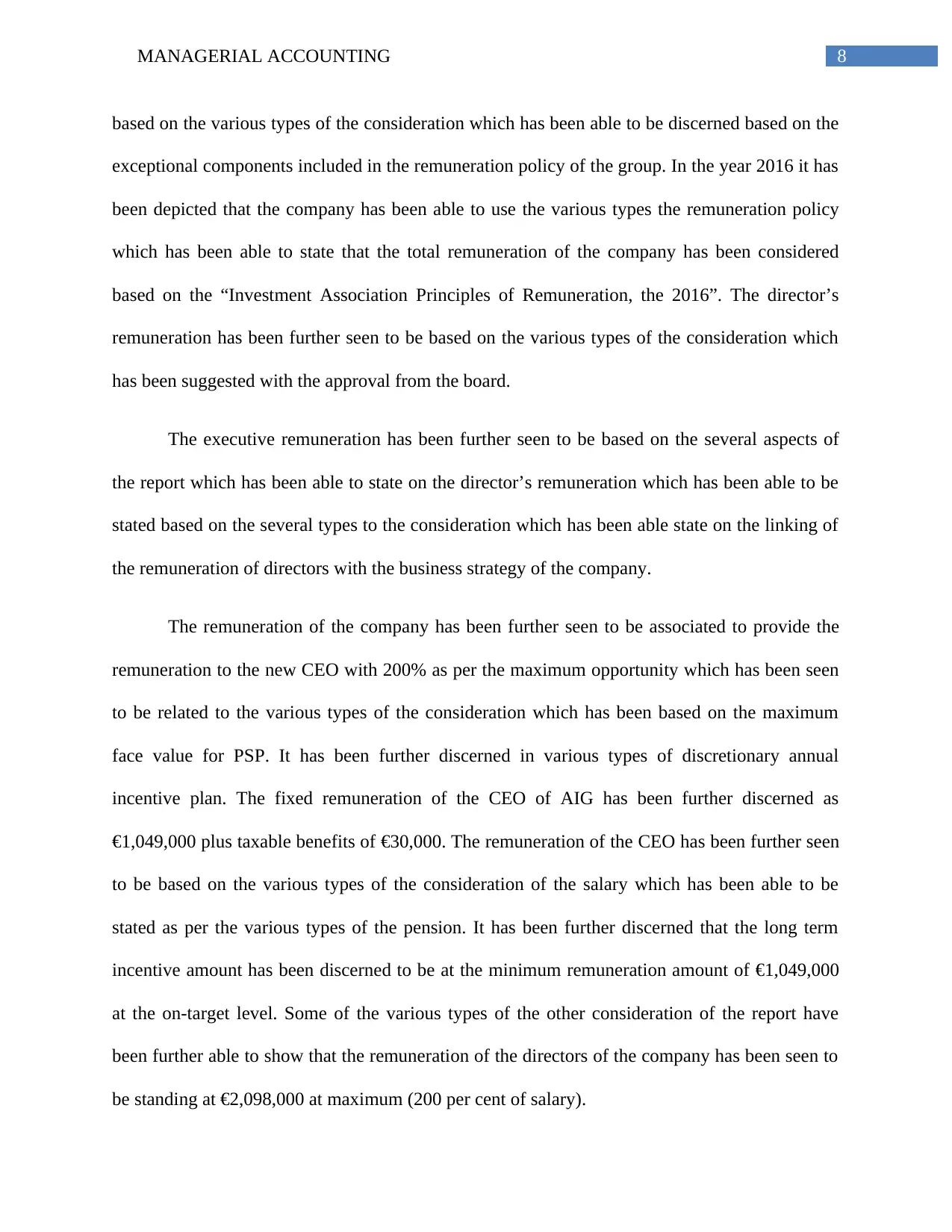
8MANAGERIAL ACCOUNTING
based on the various types of the consideration which has been able to be discerned based on the
exceptional components included in the remuneration policy of the group. In the year 2016 it has
been depicted that the company has been able to use the various types the remuneration policy
which has been able to state that the total remuneration of the company has been considered
based on the “Investment Association Principles of Remuneration, the 2016”. The director’s
remuneration has been further seen to be based on the various types of the consideration which
has been suggested with the approval from the board.
The executive remuneration has been further seen to be based on the several aspects of
the report which has been able to state on the director’s remuneration which has been able to be
stated based on the several types to the consideration which has been able state on the linking of
the remuneration of directors with the business strategy of the company.
The remuneration of the company has been further seen to be associated to provide the
remuneration to the new CEO with 200% as per the maximum opportunity which has been seen
to be related to the various types of the consideration which has been based on the maximum
face value for PSP. It has been further discerned in various types of discretionary annual
incentive plan. The fixed remuneration of the CEO of AIG has been further discerned as
€1,049,000 plus taxable benefits of €30,000. The remuneration of the CEO has been further seen
to be based on the various types of the consideration of the salary which has been able to be
stated as per the various types of the pension. It has been further discerned that the long term
incentive amount has been discerned to be at the minimum remuneration amount of €1,049,000
at the on-target level. Some of the various types of the other consideration of the report have
been further able to show that the remuneration of the directors of the company has been seen to
be standing at €2,098,000 at maximum (200 per cent of salary).
based on the various types of the consideration which has been able to be discerned based on the
exceptional components included in the remuneration policy of the group. In the year 2016 it has
been depicted that the company has been able to use the various types the remuneration policy
which has been able to state that the total remuneration of the company has been considered
based on the “Investment Association Principles of Remuneration, the 2016”. The director’s
remuneration has been further seen to be based on the various types of the consideration which
has been suggested with the approval from the board.
The executive remuneration has been further seen to be based on the several aspects of
the report which has been able to state on the director’s remuneration which has been able to be
stated based on the several types to the consideration which has been able state on the linking of
the remuneration of directors with the business strategy of the company.
The remuneration of the company has been further seen to be associated to provide the
remuneration to the new CEO with 200% as per the maximum opportunity which has been seen
to be related to the various types of the consideration which has been based on the maximum
face value for PSP. It has been further discerned in various types of discretionary annual
incentive plan. The fixed remuneration of the CEO of AIG has been further discerned as
€1,049,000 plus taxable benefits of €30,000. The remuneration of the CEO has been further seen
to be based on the various types of the consideration of the salary which has been able to be
stated as per the various types of the pension. It has been further discerned that the long term
incentive amount has been discerned to be at the minimum remuneration amount of €1,049,000
at the on-target level. Some of the various types of the other consideration of the report have
been further able to show that the remuneration of the directors of the company has been seen to
be standing at €2,098,000 at maximum (200 per cent of salary).
⊘ This is a preview!⊘
Do you want full access?
Subscribe today to unlock all pages.

Trusted by 1+ million students worldwide
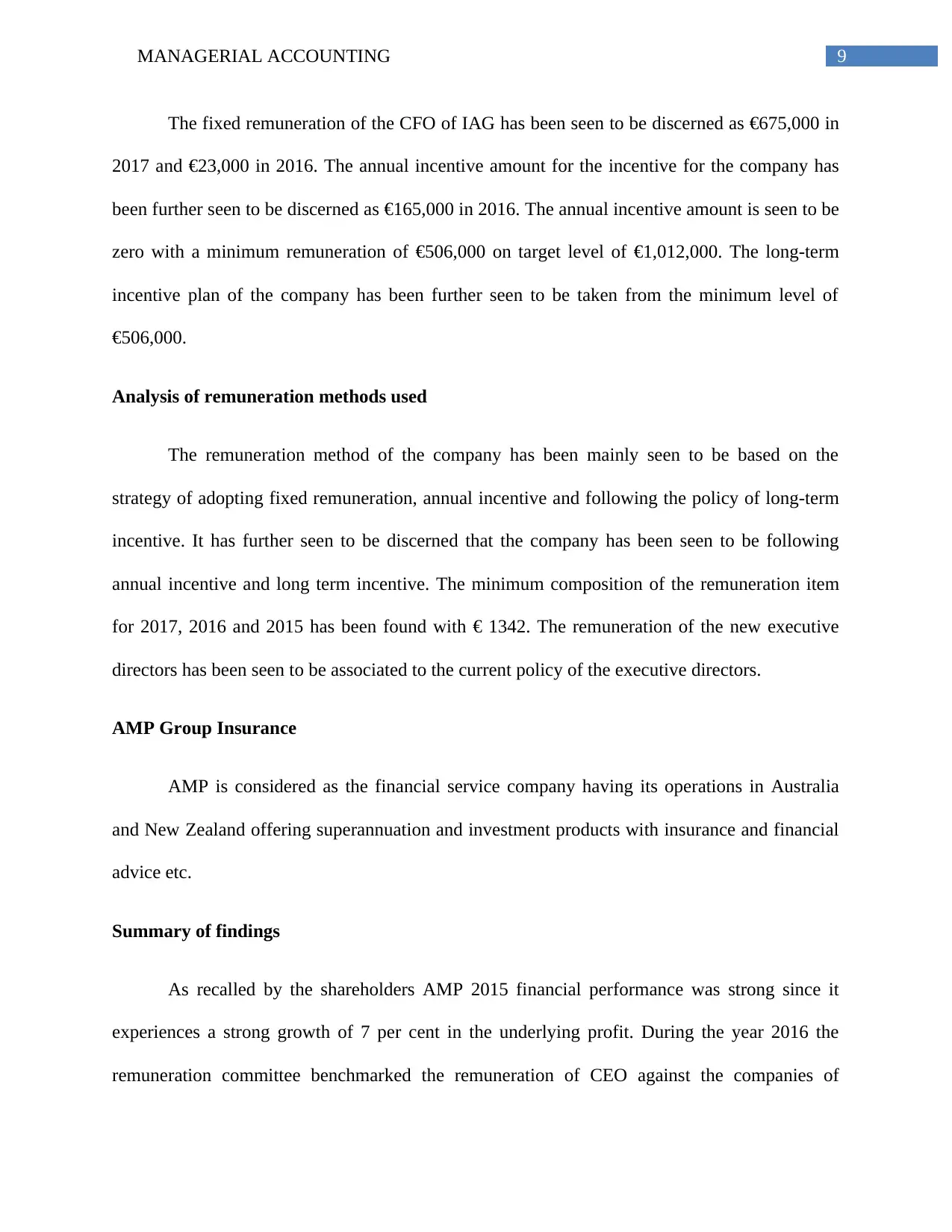
9MANAGERIAL ACCOUNTING
The fixed remuneration of the CFO of IAG has been seen to be discerned as €675,000 in
2017 and €23,000 in 2016. The annual incentive amount for the incentive for the company has
been further seen to be discerned as €165,000 in 2016. The annual incentive amount is seen to be
zero with a minimum remuneration of €506,000 on target level of €1,012,000. The long-term
incentive plan of the company has been further seen to be taken from the minimum level of
€506,000.
Analysis of remuneration methods used
The remuneration method of the company has been mainly seen to be based on the
strategy of adopting fixed remuneration, annual incentive and following the policy of long-term
incentive. It has further seen to be discerned that the company has been seen to be following
annual incentive and long term incentive. The minimum composition of the remuneration item
for 2017, 2016 and 2015 has been found with € 1342. The remuneration of the new executive
directors has been seen to be associated to the current policy of the executive directors.
AMP Group Insurance
AMP is considered as the financial service company having its operations in Australia
and New Zealand offering superannuation and investment products with insurance and financial
advice etc.
Summary of findings
As recalled by the shareholders AMP 2015 financial performance was strong since it
experiences a strong growth of 7 per cent in the underlying profit. During the year 2016 the
remuneration committee benchmarked the remuneration of CEO against the companies of
The fixed remuneration of the CFO of IAG has been seen to be discerned as €675,000 in
2017 and €23,000 in 2016. The annual incentive amount for the incentive for the company has
been further seen to be discerned as €165,000 in 2016. The annual incentive amount is seen to be
zero with a minimum remuneration of €506,000 on target level of €1,012,000. The long-term
incentive plan of the company has been further seen to be taken from the minimum level of
€506,000.
Analysis of remuneration methods used
The remuneration method of the company has been mainly seen to be based on the
strategy of adopting fixed remuneration, annual incentive and following the policy of long-term
incentive. It has further seen to be discerned that the company has been seen to be following
annual incentive and long term incentive. The minimum composition of the remuneration item
for 2017, 2016 and 2015 has been found with € 1342. The remuneration of the new executive
directors has been seen to be associated to the current policy of the executive directors.
AMP Group Insurance
AMP is considered as the financial service company having its operations in Australia
and New Zealand offering superannuation and investment products with insurance and financial
advice etc.
Summary of findings
As recalled by the shareholders AMP 2015 financial performance was strong since it
experiences a strong growth of 7 per cent in the underlying profit. During the year 2016 the
remuneration committee benchmarked the remuneration of CEO against the companies of
Paraphrase This Document
Need a fresh take? Get an instant paraphrase of this document with our AI Paraphraser
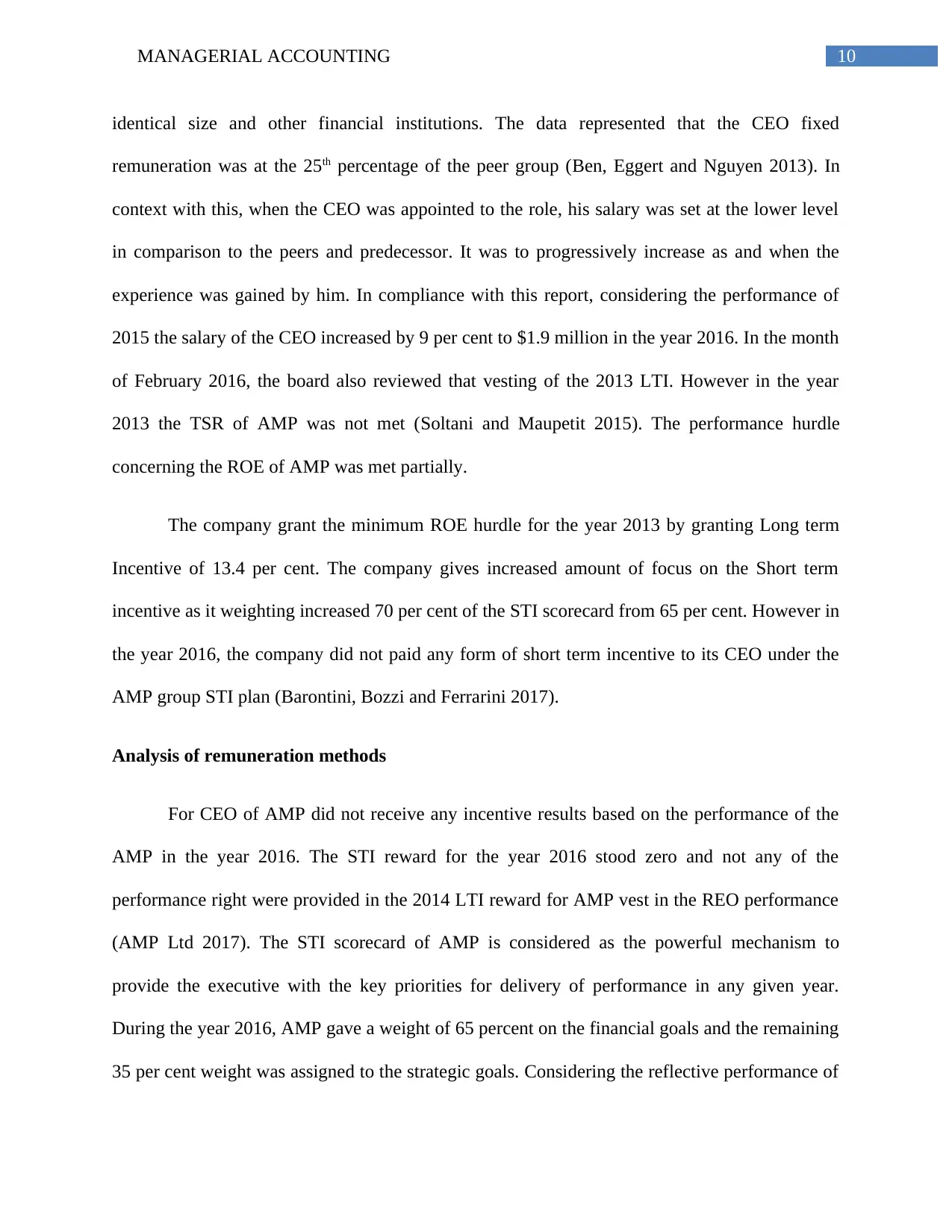
10MANAGERIAL ACCOUNTING
identical size and other financial institutions. The data represented that the CEO fixed
remuneration was at the 25th percentage of the peer group (Ben, Eggert and Nguyen 2013). In
context with this, when the CEO was appointed to the role, his salary was set at the lower level
in comparison to the peers and predecessor. It was to progressively increase as and when the
experience was gained by him. In compliance with this report, considering the performance of
2015 the salary of the CEO increased by 9 per cent to $1.9 million in the year 2016. In the month
of February 2016, the board also reviewed that vesting of the 2013 LTI. However in the year
2013 the TSR of AMP was not met (Soltani and Maupetit 2015). The performance hurdle
concerning the ROE of AMP was met partially.
The company grant the minimum ROE hurdle for the year 2013 by granting Long term
Incentive of 13.4 per cent. The company gives increased amount of focus on the Short term
incentive as it weighting increased 70 per cent of the STI scorecard from 65 per cent. However in
the year 2016, the company did not paid any form of short term incentive to its CEO under the
AMP group STI plan (Barontini, Bozzi and Ferrarini 2017).
Analysis of remuneration methods
For CEO of AMP did not receive any incentive results based on the performance of the
AMP in the year 2016. The STI reward for the year 2016 stood zero and not any of the
performance right were provided in the 2014 LTI reward for AMP vest in the REO performance
(AMP Ltd 2017). The STI scorecard of AMP is considered as the powerful mechanism to
provide the executive with the key priorities for delivery of performance in any given year.
During the year 2016, AMP gave a weight of 65 percent on the financial goals and the remaining
35 per cent weight was assigned to the strategic goals. Considering the reflective performance of
identical size and other financial institutions. The data represented that the CEO fixed
remuneration was at the 25th percentage of the peer group (Ben, Eggert and Nguyen 2013). In
context with this, when the CEO was appointed to the role, his salary was set at the lower level
in comparison to the peers and predecessor. It was to progressively increase as and when the
experience was gained by him. In compliance with this report, considering the performance of
2015 the salary of the CEO increased by 9 per cent to $1.9 million in the year 2016. In the month
of February 2016, the board also reviewed that vesting of the 2013 LTI. However in the year
2013 the TSR of AMP was not met (Soltani and Maupetit 2015). The performance hurdle
concerning the ROE of AMP was met partially.
The company grant the minimum ROE hurdle for the year 2013 by granting Long term
Incentive of 13.4 per cent. The company gives increased amount of focus on the Short term
incentive as it weighting increased 70 per cent of the STI scorecard from 65 per cent. However in
the year 2016, the company did not paid any form of short term incentive to its CEO under the
AMP group STI plan (Barontini, Bozzi and Ferrarini 2017).
Analysis of remuneration methods
For CEO of AMP did not receive any incentive results based on the performance of the
AMP in the year 2016. The STI reward for the year 2016 stood zero and not any of the
performance right were provided in the 2014 LTI reward for AMP vest in the REO performance
(AMP Ltd 2017). The STI scorecard of AMP is considered as the powerful mechanism to
provide the executive with the key priorities for delivery of performance in any given year.
During the year 2016, AMP gave a weight of 65 percent on the financial goals and the remaining
35 per cent weight was assigned to the strategic goals. Considering the reflective performance of
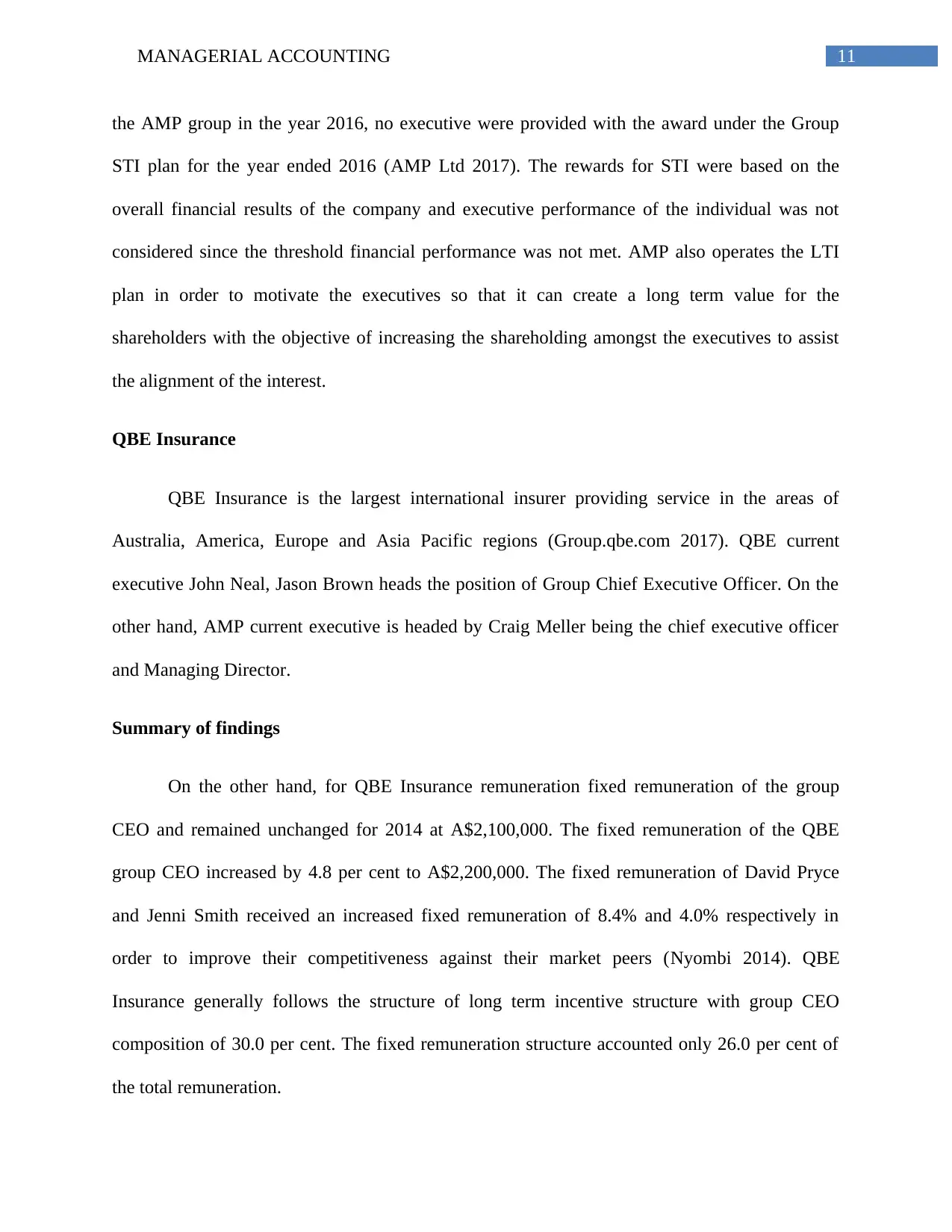
11MANAGERIAL ACCOUNTING
the AMP group in the year 2016, no executive were provided with the award under the Group
STI plan for the year ended 2016 (AMP Ltd 2017). The rewards for STI were based on the
overall financial results of the company and executive performance of the individual was not
considered since the threshold financial performance was not met. AMP also operates the LTI
plan in order to motivate the executives so that it can create a long term value for the
shareholders with the objective of increasing the shareholding amongst the executives to assist
the alignment of the interest.
QBE Insurance
QBE Insurance is the largest international insurer providing service in the areas of
Australia, America, Europe and Asia Pacific regions (Group.qbe.com 2017). QBE current
executive John Neal, Jason Brown heads the position of Group Chief Executive Officer. On the
other hand, AMP current executive is headed by Craig Meller being the chief executive officer
and Managing Director.
Summary of findings
On the other hand, for QBE Insurance remuneration fixed remuneration of the group
CEO and remained unchanged for 2014 at A$2,100,000. The fixed remuneration of the QBE
group CEO increased by 4.8 per cent to A$2,200,000. The fixed remuneration of David Pryce
and Jenni Smith received an increased fixed remuneration of 8.4% and 4.0% respectively in
order to improve their competitiveness against their market peers (Nyombi 2014). QBE
Insurance generally follows the structure of long term incentive structure with group CEO
composition of 30.0 per cent. The fixed remuneration structure accounted only 26.0 per cent of
the total remuneration.
the AMP group in the year 2016, no executive were provided with the award under the Group
STI plan for the year ended 2016 (AMP Ltd 2017). The rewards for STI were based on the
overall financial results of the company and executive performance of the individual was not
considered since the threshold financial performance was not met. AMP also operates the LTI
plan in order to motivate the executives so that it can create a long term value for the
shareholders with the objective of increasing the shareholding amongst the executives to assist
the alignment of the interest.
QBE Insurance
QBE Insurance is the largest international insurer providing service in the areas of
Australia, America, Europe and Asia Pacific regions (Group.qbe.com 2017). QBE current
executive John Neal, Jason Brown heads the position of Group Chief Executive Officer. On the
other hand, AMP current executive is headed by Craig Meller being the chief executive officer
and Managing Director.
Summary of findings
On the other hand, for QBE Insurance remuneration fixed remuneration of the group
CEO and remained unchanged for 2014 at A$2,100,000. The fixed remuneration of the QBE
group CEO increased by 4.8 per cent to A$2,200,000. The fixed remuneration of David Pryce
and Jenni Smith received an increased fixed remuneration of 8.4% and 4.0% respectively in
order to improve their competitiveness against their market peers (Nyombi 2014). QBE
Insurance generally follows the structure of long term incentive structure with group CEO
composition of 30.0 per cent. The fixed remuneration structure accounted only 26.0 per cent of
the total remuneration.
⊘ This is a preview!⊘
Do you want full access?
Subscribe today to unlock all pages.

Trusted by 1+ million students worldwide
1 out of 20
Related Documents
Your All-in-One AI-Powered Toolkit for Academic Success.
+13062052269
info@desklib.com
Available 24*7 on WhatsApp / Email
![[object Object]](/_next/static/media/star-bottom.7253800d.svg)
Unlock your academic potential
Copyright © 2020–2025 A2Z Services. All Rights Reserved. Developed and managed by ZUCOL.





